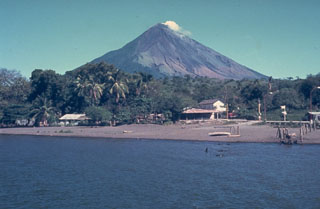Report on Concepcion (Nicaragua) — November 1994
Bulletin of the Global Volcanism Network, vol. 19, no. 11 (November 1994)
Managing Editor: Richard Wunderman.
Concepcion (Nicaragua) Fumarolic activity persists
Please cite this report as:
Global Volcanism Program, 1994. Report on Concepcion (Nicaragua) (Wunderman, R., ed.). Bulletin of the Global Volcanism Network, 19:11. Smithsonian Institution. https://doi.org/10.5479/si.GVP.BGVN199411-344120
Concepcion
Nicaragua
11.538°N, 85.622°W; summit elev. 1700 m
All times are local (unless otherwise noted)
The fumarole at 1,550 m elevation directly N of the crater, observed in January and April 1993, remained active in November 1994. The fumarole was located on a crescentic fault with a downthrow to the N, which is probably related to outward/downward movement on the N flank. Clouds obscured most of the fumarole sites during a crater visit in April 1994; those seen had not changed since 1993. A 20-point deformation survey network was installed from 13 November to 27 December 1994 to measure spreading rates (van Wyk de Vries and others, 1993). The network will also be used for general monitoring.
Reference. van Wyk de Vries, B., Brown, G.C., and Borgia, A., 1993, Spreading at Concepción volcano, Nicaragua (abs.), in EOS, Abstracts of the American Geophysical Union, 1993 Fall Meeting, San Francisco.
Geological Summary. Volcán Concepción is one of Nicaragua's highest and most active volcanoes. The symmetrical basaltic-to-dacitic stratovolcano forms the NW half of the dumbbell-shaped island of Ometepe in Lake Nicaragua and is connected to neighboring Madera volcano by a narrow isthmus. A steep-walled summit crater is 250 m deep and has a higher western rim. N-S-trending fractures on the flanks have produced chains of spatter cones, cinder cones, lava domes, and maars located on the NW, NE, SE, and southern sides extending in some cases down to Lake Nicaragua. Concepción was constructed above a basement of lake sediments, and the modern cone grew above a largely buried caldera, a small remnant of which forms a break in slope about halfway up the N flank. Frequent explosive eruptions during the past half century have increased the height of the summit significantly above that shown on current topographic maps and have kept the upper part of the volcano unvegetated.
Information Contacts: B. van Wyk de Vries, Open Univ; Pedro Hernandez, INETER.

